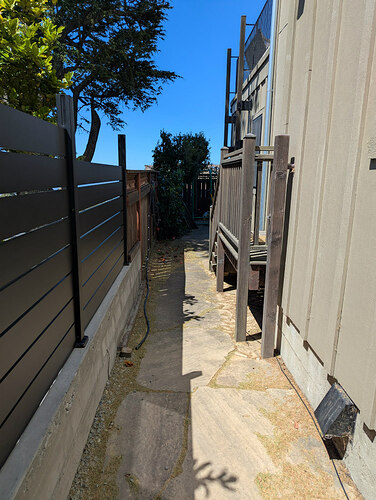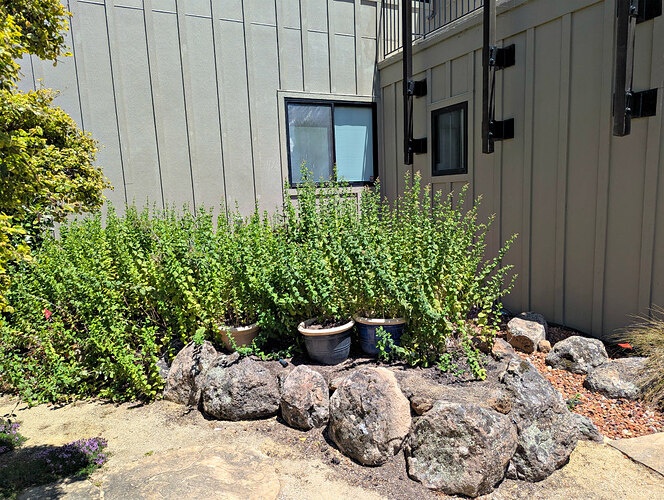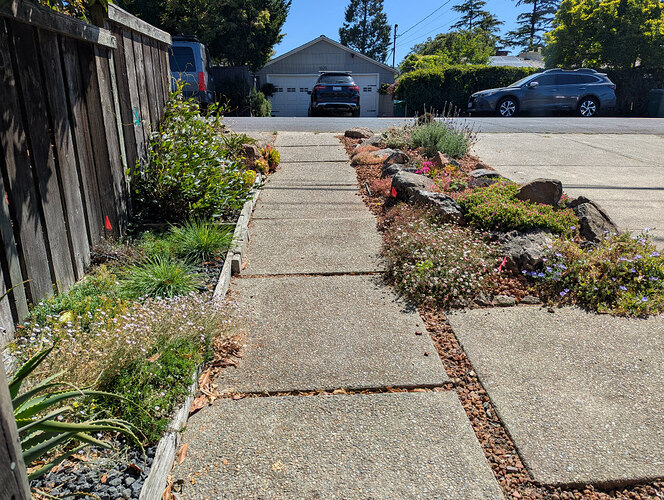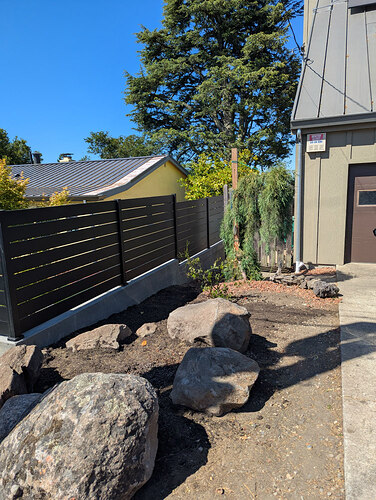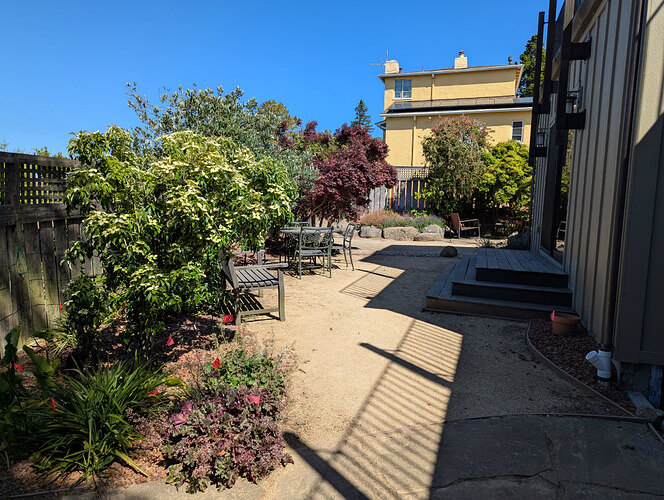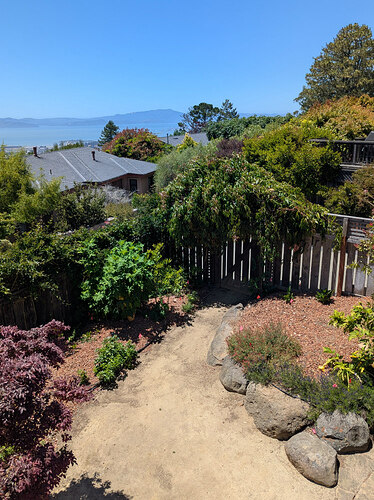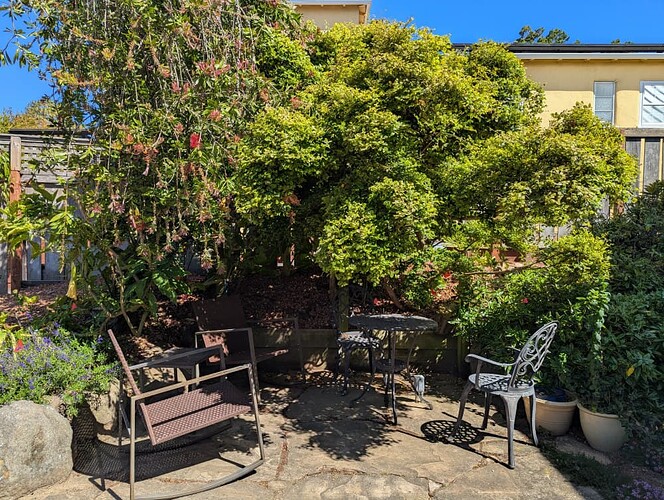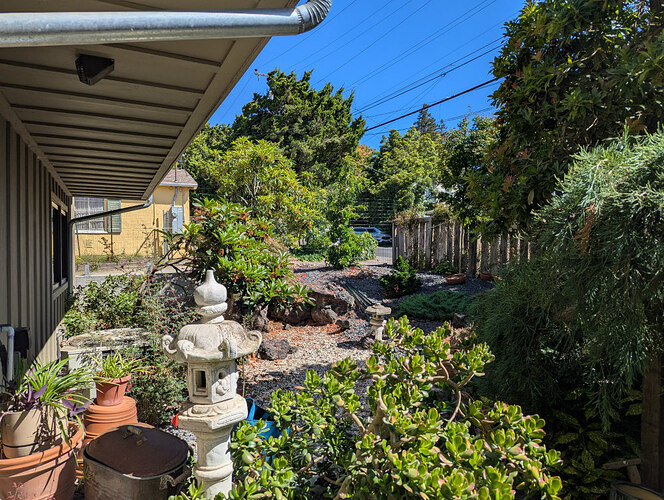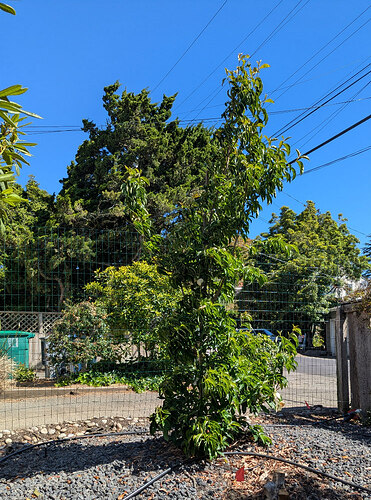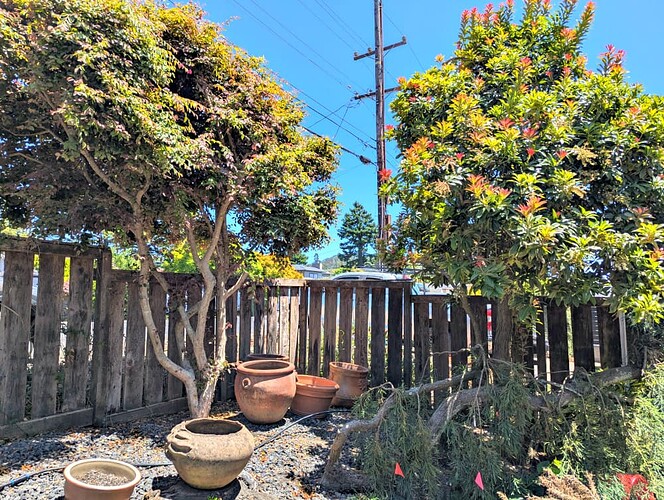I have been clearing defensible space in my yard since 2023. This summer of 2025, I am two+ years into my (slow) project, and hope to reach final compliance completion around December this year.
My evolution with respect to wildfire mitigation, from denier to adopter
We came back to our house on the Berkeley Ridge in late summer 2019, in time for school, after a few years in the Midwest. Because we had been gone, the change to the vegetation was immediately apparent to us: many fewer yards with lawn (in fact, practically none), less lush of a landscape, drier or less thirsty plants, yet still magnificent vegetation all around us.
My wife realized right away, in 2020, that our vulnerability to wildfire had changed since we had bought our home in 1997. She put together a go-to bag and started planning for evacuations. I was in denial. I had landscaped our whole yard shortly after we had purchased the house. As we all did at the time, I had planted more than half of the green vegetation right by the house or by my neighbors’ homes—but I had carefully selected plants based on their fire resistance: fruit trees, and glossy, well irrigated shrubs such as European laurels, michelias or camellias. I was certain that these had been the right plants to grow.
Being a scientist by formation, I decided, in 2020, to research the subject in depth and prove BFD’s advice wrong. I spent the next year researching wildfire, and read probably 3-400 papers on wildfire science, fire science and ignitability. After a few weeks, it had become clear to me that I was likely wrong—but, being a stubborn man, I had to prove it to myself. It took me a year to do so: I was wrong, not in what I had planted, but in how and where I had planted it.
At this stage I could not deny any more. Instead, I became angry for a year. I knew that my landscape was wrong for wildfire but I was not emotionally ready to change it—going through the regular stages of grief. Finally, I went into some form of limited acceptance. In late 2022, I started clearing the plants that were clearly wrong (bamboos and junipers). In early 2023, I started making plans for the rest of the yard. I have pursued these plans for the past 2 years, and I am not too far from completion.
A new landscaping project
As a clarification, I envisioned, in 2023, more than simply compliance with future rules which did not exist at the time. I decided on a partial re-landscape of my whole yard, front and back. Removing vegetation was a small part of it—renewing it was a much bigger part. In fact, I made the firm decision, early on, that I would have at least as much vegetation at that end as I had at the beginning. The end result, though, would be much more wildfire-resistant.
Clearing Zone 0
For most of us, it is possible to keep all or most of the trees planted in Zone 0. I had, however, planted my trees so close to the house and that it impossible to prune them away from the walls. I ended up clearing everything I had planted in Zone 0, either through cutting or transplanting. I do intend to plant trees back in zone 0, but further away, and in a manner where they will be easy to train away from the house.
For instance, the back alley has been cleared of all vegetation on both sides, with the exception of two small camellias, at the end, planted on the opposite side to the house, that are being pruned and staked away from Zone 0. The debris on the ground comes from my neighbor’s beautiful deodar cedar, and needs to get swept bimonthly to avoid becoming a fire danger. Until a few months ago, the separation fence to my neighbor was wood, but they and we shared the cost of a common project to build a small concrete wallet and a privacy metal fence on top of it, that can be seen in the picture. The fence, being parallel to the house, did not need to be replaced, but, because my neighbor’s house and mine are within 20 feet of each other, it is much safer to take out combustible material between our two houses.
We had spread our last load of redwood mulch around the house in 2020. In 2023, we dressed the soil everywhere with 2" of compost, then laid 4" of 5/8" volcanic rock everywhere around the yard, including, in particular, in Zone 0.
Recreating landscape in front of the Zone 0
This corner of the house still has the most amount of work to go. We removed all the climbers and shrubs along the wall, and left a 5 ft rock bed alongside the wall, edged with large moss rock. In front of the moss rock “terrace” we added two more triangles of elevated areas. Both are terraced with larger moss rock. The back will be a shrub bed that will replace what we had against the walls. The front will be an herb garden. Right now, the only thing growing there is a forest of mint.
Zone 1: rock gardens
The new regulations give us a lot of flexibility in Zone 1, between small non-woody plants anywhere, separated shrubs and trees, continuous tree canopy that is limbed off between 4 inches and 6 feet, and “green islands” of 10 feet in diameter for groups of shrubs. We used different methods in different parts of the yard.
In front of the house, we had three 20-foot-long beds extending away from the house, that used to be largely constituted of tall grasses (up to 7 feet tall), waving back and forth with the winds, but also looking somewhat wild and unkept. In spring 2024, we removed the grasses in two of them and replaced them with mostly irrigated native plants in a rock garden. We created the rock garden by buying moss rock, at $240 per ton, positioning them in the bed, then adding decent soil around it, and finally laying out volcanic rock mulch on top.
On the other side of the driveway, where we put up the new fence, we also took out all the grasses but could not do any landscaping until the fence was done. Now that it is complete, we added some rocks to create a little promontory. We now need to add soil and rock mulch, and plant some natives around the rocks. In the back, one can see an original sequoia pendulum that I planted 18 years ago, and a small Meyer lemon dwarf that I transplanted from the other side of the house (one of few transplants that succeeded last winter). The wood gate needs to be swapped to metal over the summer.
Zone 1: green islands
In the backyard, after we had cleared our Zone 0, we created multiple green islands, of approximately 10 feet in diameter each, separated by fire breaks in the form of open spaces of rock mulch, decomposed granite, or, sometimes, limited amounts of non-woody plants. Each provides some shade and a small area to gather in. The first one in the picture consists of an dwarf evergreen dogwood and a pineapple-guava surrounding a bench. The second consists of two loropetalum and a camellia shading a table and four chairs. In the back, my favorite green island has a brugmansia, a bottlebrush, and a loropetalum weeping over a small work table and rocking chairs. I work there often, surrounded by hummingbirds and bees.
Zone 1: planting more trees
After establishing green islands around the garden, in the furthest corner of my back garden, where I have a large clematis armandii growing over the fence, I actually have plenty of room to plant a good-sized tree—not sure what it will be.
Shrinking a green island down to 10 ft
My favorite green island is actually too wide: instead of 10 ft of diameter, it is a bit more than 13 ft in diameter. I am unable to shrink it much more because the brugmansia and the bottlebrush are planted right on the edge of it. So, last year, I planted a second bottlebrush and a second brugmansia closer to the center of it. In another year or so, they will be big enough to start weeping, at which time I will cut the original bottlebrush and brugmansia, which will shrink my green island to about 10 ft in diameter.
Zone 1: an evolving Japanese garden
I had planted a lush Japanese garden in the front, partially inherited from the previous owner. I removed almost all the lower plantings along the house, with a few still left to clear this winter.
Close to the road, this garden had too many trees, some of which were aging out. I removed almost all of them. As a replacement, last year I planted what will become a very large evergreen dogwood, that I expect to grow to 30-40 ft. It has already gained 2.5 feet since its late spring 2024. We want to add some larger rocks on the street side of it to balance the landscape.
On the other side, we are progressively pruning a large pieris japonica and a loropetalum, hoping to be able to separate them and prune them up enough that they can pass muster. We are planning to put some small rock plants in large pots around them so as to limit the amount of understory while still providing some vertical depth under them.
Progress and cost
I discussed my actual cost of complying with Zone 0 in a different post. In Zone 1, the cost of this landscaping project has not been negligible, but it is limited. The rock mulch and moss rock amount to about $3,000, and the cost of labor to move and spread it is likely $2,000. Over 3 years, I spent about $4,500 in arborist work to do the fine pruning that I could not do myself. New plantings cost me about $2,500 over the past three years as well.
Progress and status
I figure that I have about 15-20% left to do to be fully Zone 0 and Zone 1 compliant. I am aiming for December, since I have a bit more transplanting to do, which will be done during dormancy, around early December. There is plenty left to do, but I am starting to see an end to the process. I am probably another 2 years away from completing the landscape though: there are more trees and shrubs to plant, and a couple more beds to create. I have reached, I think, the nadir of the process: I have less vegetation than I ever had before or that I will ever have. But being able to plant again for the past year has made a huge difference to my mood: what gardener isn’t happy when he/she plants new things in the ground? I had promised myself that I would have at least as much vegetation in the end as I had at the beginning, and I am pretty sure that I will make good on my promise.
